Resultados de la búsqueda67 resultados
-

A VR-enhanced rollover car simulator and edutainment application for increasing seat belt use awareness
José V. Riera, Sergio Casas, Francisco Alonso, Marcos Fernández
(2021). ArticleComputers, Special Issue Game-Based Learning, Gamification in Education and Serious Games. Num.10(5):55
Most countries have active road safety policies that seek the objective of reducing deaths in traffic accidents. One of the main factors in this regard is the awareness of the safety measures, one of the most important being the correct usage of the seat belt, a device that is known to save thousands of lives every year. The presented work shows a VR-enhanced edutainment application designed to increase awareness on the use of seat belts. For this goal, a motorized rollover system was developed that, synchronized with a VR application (shown in a head-mounted display for each user inside a real car), rolls over this car with up to four passengers inside. This way, users feel the sensations...
Most countries have active road safety policies that seek the objective of reducing deaths in traffic accidents. One of the main factors in this regard is the awareness of the safety measures, one of the most important being the correct usage of the seat belt, a device that is known to save thousands of lives every year. The presented work shows a VR-enhanced edutainment application designed to increase awareness on the use of seat belts. For this goal, a motorized rollover system was developed that, synchronized with a VR application (shown in a head-mounted display for each user inside a real car), rolls over this car with up to four passengers inside. This way, users feel the sensations of a real overturn and therefore they realize the consequences and the results of not wearing a seat belt. The system was tested for a month in the context of a road safety exhibition in Dammam, Saudi Arabia, one of the leading countries in car accidents per capita. More than 500 users tested and assessed the usefulness of the system. We measured, before and after the rollover experience, the perception of risk of not using the seat belt. Results show that awareness regarding the use of seat belts increases very significantly after using the presented edutainment tool.
Leer más Ocultar DOI: 10.3390/computers10050055ISSN: 2073-431X -

Could road safety education (RSE) help parents protect children? Examining their driving crashes with children on board
Francisco Alonso, Sergio Useche, Eliseo Valle. Cristina Esteban, Javier Gene-Morales
(2021). ArticleInternational Journal of Environmental Research and Public Health. Num.18(7), 3611
Recent evidence suggests that driving behavior and traffic safety outcomes of parents may be influenced by the extent to which they receive information and education on road safety, as well as the fact of driving with their children on board, which may increase their risk perception. However, there are no studies specifically addressing the case of crashes suffered while driving with children. Hence, this study aimed to describe the relationship between road safety education-related variables and parents’ traffic safety outcomes while driving with children on board. For this cross-sectional study, data was retrieved from a sample composed of 165 Spanish parents—all of them licensed...
Recent evidence suggests that driving behavior and traffic safety outcomes of parents may be influenced by the extent to which they receive information and education on road safety, as well as the fact of driving with their children on board, which may increase their risk perception. However, there are no studies specifically addressing the case of crashes suffered while driving with children. Hence, this study aimed to describe the relationship between road safety education-related variables and parents’ traffic safety outcomes while driving with children on board. For this cross-sectional study, data was retrieved from a sample composed of 165 Spanish parents—all of them licensed drivers—with a mean age of 45.3 years. Through binary logistic regression (logit) analysis, it was found that factors such as gender, having received road safety education (RSE), and having been sanctioned for the performance of risky driving behavior contribute to modulating the likelihood of suffering crashes while driving with children on board. Gender differences showed a riskier status for male parents. In this study, a set of risk factors explaining the involvement in traffic crashes when driving with children as passengers was identified among parents: gender, traffic sanctions, valuation, and exposure to road safety campaigns. Also, substantial limitations in the self-reported degree of received RSE were found, especially considering that risky driving behavior and traffic crash rates with children on board still have a high prevalence among parents.
Leer más Ocultar DOI: 10.3390/ijerph18073611ISSN: 1660-4601 -
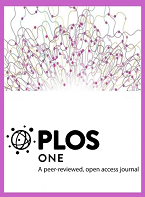
Comparing oculomotor efficiency and visual attention between drivers and non-drivers through the Adult Developmental Eye Movement (ADEM) test: A visual-verbal test.
Andrés Gené-Sampedro, Francisco Alonso, Celia Sánchez-Ramos, Sergio Useche
(2021). ArticlePlos One. Num.16(2): e0246606
Objective The objective of this study was to assess and compare drivers’ and non-drivers’ outcomes in the Adult Developmental Eye Movement test (ADEM), a visual-verbal test that measures the time needed to read series of numbers in both a vertical and horizontal reading pattern. A set of driving parameters (i.e., experience, risk exposure, and day and night perceived difficulty) and demographic variables (i.e., age, gender, and academic level) were considered as potential predictors of the test performance. Methods For this cross-sectional study, 302 healthy subjects (age range 20 to 86 years old) completed a self-reported questionnaire aimed at retrieving data on the independent...
Objective The objective of this study was to assess and compare drivers’ and non-drivers’ outcomes in the Adult Developmental Eye Movement test (ADEM), a visual-verbal test that measures the time needed to read series of numbers in both a vertical and horizontal reading pattern. A set of driving parameters (i.e., experience, risk exposure, and day and night perceived difficulty) and demographic variables (i.e., age, gender, and academic level) were considered as potential predictors of the test performance. Methods For this cross-sectional study, 302 healthy subjects (age range 20 to 86 years old) completed a self-reported questionnaire aimed at retrieving data on the independent variables, and underwent the ADEM in order to obtain the dependent outcomes. 214 (70.9%) of the participants were drivers. Non-parametric analyses and multilevel linear regression were used to assess differences between the variables and a prediction model. Also, some correlations were evaluated through the Spearman test. Results Drivers showed significantly better test performance than non-drivers. The age, driving experience, and perceived difficulty in driving at night were obtained as potential predictors of the test performance with the applied linear regression model. Conclusion The ADEM may be a practical, non-expensive, easy-to-apply tool in the assessment of drivers, useful for obtaining or renewing the driving license. This test may help in the detection of impairments in the saccadic efficiency that could have a detrimental effect on the driving performance.
Leer más Ocultar DOI: 10.1371/journal.pone.0246606ISSN: 1932-6203 -
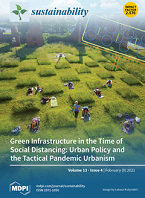
“Not as safe as I believed”: Differences in perceived and self-reported cycling behavior between riders and non-riders
Sergio Useche, Javier Gené-Morales, Félix Siebert, Francisco Alonso, Luis Montoro
(2021). ArticleSustainability. Num.13(4), 1614
Cycling behavior remains a key issue for explaining several traffic causalities occurring every day. However, recent studies have shown how the assessment of the own safety-related behaviors on the road may substantially differ from how third parties assess them. Thus, the aim of this study was to evaluate the differences between cyclists’ self-reported behavior and the proxyreported behavior that other (non-cyclist) road users perceive from bike riders. For this purpose, this study used data from two samples: (i) 1064 cyclists (M = 32.83 years) answering the Cycling Behavior Questionnaire—CBQ, and (ii) 1070 non-cyclists (M = 30.83 years) answering an adapted version of the CBQ for external...
Cycling behavior remains a key issue for explaining several traffic causalities occurring every day. However, recent studies have shown how the assessment of the own safety-related behaviors on the road may substantially differ from how third parties assess them. Thus, the aim of this study was to evaluate the differences between cyclists’ self-reported behavior and the proxyreported behavior that other (non-cyclist) road users perceive from bike riders. For this purpose, this study used data from two samples: (i) 1064 cyclists (M = 32.83 years) answering the Cycling Behavior Questionnaire—CBQ, and (ii) 1070 non-cyclists (M = 30.83 years) answering an adapted version of the CBQ for external raters—ECBQ. The results show how the self-reported and proxy-reported behaviors of cyclists greatly differ in terms of all behavioral factors composing the CBQ model, i.e., traffic violations, riding errors, and positive behaviors. Also, external raters (non-cyclists) are those targeting significantly riskier behaviors than those self-reported by cyclists. These discrepancies between perceived behaviors may give rise to conflicting viewpoints on the interaction between bicycle riders and other road users. Therefore, this study underscores the importance of behavioral awareness, providing highlights for future studies on the behavioral interaction between cyclists and other road users. Results can be used to improve the road safety of all road users by giving indications on self-and proxy-perceived safety-related behaviors and visibility of protective riding habits.
Leer más Ocultar DOI: 10.3390/su13041614 -
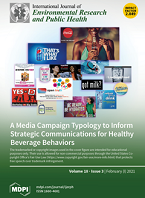
Socioeconomic Status, Health and Life-Style Settings as Psychosocial Risk Factors for Road Crashes in Young People: Assessing the Colombian Case
Andrea Serge, Johana Quiroz, Francisco Alonso, Luis Montoro
(2021). ArticleInternational Journal of Environmental Research and Public Health. Num.18(3), 886
The social determinants of health influence both psychosocial risks and protective factors, especially in high-demanding contexts, such as the mobility of drivers and non-drivers. Recent evidence suggests that exploring socioeconomic status (SES), health and lifestyle-related factors might contribute to a better understanding of road traffic crashes (RTCs). Thus, the aim of this study was to construct indices for the assessment of crash rates and mobility patterns among young Colombians who live in the central region of the country. The specific objectives were developing SES, health and lifestyle indices, and assessing the self-reported RTCs and mobility features depending on these...
The social determinants of health influence both psychosocial risks and protective factors, especially in high-demanding contexts, such as the mobility of drivers and non-drivers. Recent evidence suggests that exploring socioeconomic status (SES), health and lifestyle-related factors might contribute to a better understanding of road traffic crashes (RTCs). Thus, the aim of this study was to construct indices for the assessment of crash rates and mobility patterns among young Colombians who live in the central region of the country. The specific objectives were developing SES, health and lifestyle indices, and assessing the self-reported RTCs and mobility features depending on these indices. A sample of 561 subjects participated in this cross-sectional study. Through a reduction approach of Principal Component Analysis (PCA), three indices were constructed. Mean and frequency differences were contrasted for the self-reported mobility, crash rates, age, and gender. As a result, SES, health and lifestyle indices explained between 56.3–67.9% of the total variance. Drivers and pedestrians who suffered crashes had higher SES. A healthier lifestyle is associated with cycling, but also with suffering more bike crashes; drivers and those reporting traffic crashes have shown greater psychosocial and lifestyle-related risk factors. Regarding gender differences, men are more likely to engage in road activities, as well as to suffer more RTCs. On the other hand, women present lower healthy lifestyle-related indices and a less active implication in mobility. Protective factors such as a high SES and a healthier lifestyle are associated with RTCs suffered by young Colombian road users. Given the differences found in this regard, a gender perspective for understanding RTCs and mobility is highly suggestible, considering that socio-economic gaps seem to differentially affect mobility and crash-related patterns
Leer más Ocultar DOI: 10.3390/ijerph18030886ISSN: 1660-4601 -
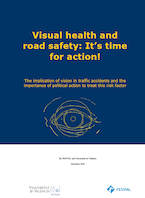
Visual health and road safety: It’s time for action!: The implication of vision in traffic accidents and the importance of political action to treat this risk factor
Luis Montoro, Ignacio Lijarcio, Sergio Useche, Cristina Catalá, Javier LLamazares
(2021). InformesEl documento recoge de una manera sintética los principales hallazgos sobre la importancia de la visión en la seguridad vial, con el objetivo de continuar reduciendo los siniestros viales en España y en el resto del mundo producidos por una mala salud visual. Las conclusiones obtenidas indican que la salud visual es un factor importante a tener en cuenta en la seguridad vial y que requiere el continuo desarrollo de investigaciones en conducción nocturna y diurna, la promoción de la salud visual en las personas conductoras, así como una mejora de los protocolos de exploración visual y la creación de acciones de sensibilización a toda la ciudadanía. El compromiso con la seguridad vial y el...
El documento recoge de una manera sintética los principales hallazgos sobre la importancia de la visión en la seguridad vial, con el objetivo de continuar reduciendo los siniestros viales en España y en el resto del mundo producidos por una mala salud visual. Las conclusiones obtenidas indican que la salud visual es un factor importante a tener en cuenta en la seguridad vial y que requiere el continuo desarrollo de investigaciones en conducción nocturna y diurna, la promoción de la salud visual en las personas conductoras, así como una mejora de los protocolos de exploración visual y la creación de acciones de sensibilización a toda la ciudadanía. El compromiso con la seguridad vial y el desarrollo de iniciativas e investigaciones de este calado ayudará a conseguir la meta trazada en este nuevo decenio de acción por la seguridad vial declarado en agosto de 2020 por la Asamblea General de Naciones Unidas.
Leer más Ocultar -

Enseñanzas para la gestión de la accidentalidad en emplazamientos peligrosos en las carreteras
Francisco Alonso, Cristina Esteban, Enrique Casquero, Jose Luis Velarte, Jorge Suarez, Juan Carlos Pastor
(2020). LlibreEl presente documento se ha centrado en manifestar la necesidad fundamental, común a todos los países, de actuar sobre los emplazamientos peligrosos (denominados por la literatura científica con un sinfín de términos), y precisamente en este sentido, desarrollar políticas encaminadas a la adecuada implantación de sistemas de gestión de la seguridad vial (tanto en fase de proyecto como en fase de explotación, como se deja constancia en documentos marco tan importantes como la Directiva Europea 2019/1936). El objetivo es claro: se debe trabajar para alcanzar el concepto de Sistema Seguro, en el cual los ingenieros viales se cercioren de que la red de carreteras se ha diseñado y mantenido...
El presente documento se ha centrado en manifestar la necesidad fundamental, común a todos los países, de actuar sobre los emplazamientos peligrosos (denominados por la literatura científica con un sinfín de términos), y precisamente en este sentido, desarrollar políticas encaminadas a la adecuada implantación de sistemas de gestión de la seguridad vial (tanto en fase de proyecto como en fase de explotación, como se deja constancia en documentos marco tan importantes como la Directiva Europea 2019/1936). El objetivo es claro: se debe trabajar para alcanzar el concepto de Sistema Seguro, en el cual los ingenieros viales se cercioren de que la red de carreteras se ha diseñado y mantenido desde la perspectiva de la seguridad. Se espera que el presente documento no solamente sea de utilidad por su carácter divulgativo, sino también por su carácter práctico, ya que puede servir de referencia a todos los actores que decidan enfrentarse a la problemática de la accidentalidad desde el punto de vista de la gestión de emplazamientos peligrosos, gracias a la adopción de estrategias de éxito y a la posibilidad de “esquivar” los errores aprendidos de la experiencia.
Leer más Ocultar ISBN: 978-84-09-21202-6 -
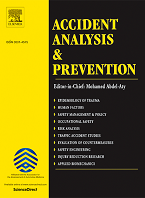
Are Latin American cycling commuters “at risk”? A comparative study on cycling patterns, behaviors, and crashes with non-commuter cyclists
Sergio Useche, Cristina Esteban, Francisco Alonso, Luis Montoro
(2020). ArticleAccident Analysis and Prevention. Num.150:105915
Introduction As part of the transformation of urban transportation dynamics, commuter cycling has acquired a high relevance as an alternative mode of transport in different countries, and Latin America seems to be one of the main focus of this worldwide “revolution”. However, the high rates of crashes and injuries suffered by commuters have become a relevant issue in the field of road safety, especially in emerging regions with low cycling tradition, where social and infrastructural gaps may endanger the cyclists’ safety. Objectives This study had two objectives. First, to compare key safe cycling-related variables between cycling commuters and non-commuters; and second, to...
Introduction As part of the transformation of urban transportation dynamics, commuter cycling has acquired a high relevance as an alternative mode of transport in different countries, and Latin America seems to be one of the main focus of this worldwide “revolution”. However, the high rates of crashes and injuries suffered by commuters have become a relevant issue in the field of road safety, especially in emerging regions with low cycling tradition, where social and infrastructural gaps may endanger the cyclists’ safety. Objectives This study had two objectives. First, to compare key safe cycling-related variables between cycling commuters and non-commuters; and second, to differentially asses the effect of individual and cycling-related variables on their self-reported crash rates. Method: For this cross-sectional research, the data provided by 577 Latin American urban cyclists from three countries (Argentina, Colombia and Mexico) with a mean age of 32.7 years was used. They answered a questionnaire on cycling habits, risk perception, rule knowledge, cycling behaviors and riding crashes. Results The outcomes of this study showed that, despite having a higher risk perception, cycling commuters perform deliberate risky cycling behaviors (traffic violations) more frequently, and they suffer more crashes; cycling commuters report higher rates of psychological distress, and a lower degree of rule knowledge and protective behaviors than non-commuters. Furthermore, structural similarities and differences in the explanation of cycling crashes were found across commuters and non-commuters. Conclusion The results of this study suggest that non-commuters, whose purposes for cycling are more aimed at leisure and occasional trips, perform less risky behaviors but suffer more cycling distractions, whereas commuters are comparatively more exposed to behavioral-based safety risks, and suffer more frequent crashes. Since recent evidence forecasts that urban cycling will keep growing in Latin American cities, it is necessary to implement policies and educational/training improvements that may enhance the safety and health of cyclists in these countries.
Leer más Ocultar DOI: 10.1016/j.aap.2020.105915ISSN: 0001-4575 -
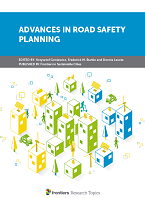
Does Urban Security Modulate Transportation Choices and Travel Behavior of Citizens? A National Study in the Dominican Republic
Francisco Alonso, Sergio Useche, Mireia Faus, Cristina Esteban
(2020). ArticleFrontiers in Sustainable Cities. Num.2:42
Introduction: Traditionally, the scientific literature on urban and transportation dynamics addresses many topics, but the security-related outcomes of users remain a pending issue, especially in emerging countries and their cities. Nevertheless, recent evidence suggests that, especially in developing countries, security issues may influence people's decision-making in the choice of transport means, daily urban-trip patterns and road behaviors of users. Objective: The purpose of this study was to explore the relationships between the perceived security (in both urban environments and public transport systems) and the daily-travel behavior and trip patterns of the Dominican Republic...
Introduction: Traditionally, the scientific literature on urban and transportation dynamics addresses many topics, but the security-related outcomes of users remain a pending issue, especially in emerging countries and their cities. Nevertheless, recent evidence suggests that, especially in developing countries, security issues may influence people's decision-making in the choice of transport means, daily urban-trip patterns and road behaviors of users. Objective: The purpose of this study was to explore the relationships between the perceived security (in both urban environments and public transport systems) and the daily-travel behavior and trip patterns of the Dominican Republic population. Methods: This cross-sectional study, performed in 2019, analyzed data collected from 1,026 inhabitants from different cities of the Dominican Republic (54% females and 46% males), who completed a survey on security issues, travel behaviors and transportation-related habits. Results: The results of this research suggest that demographic factors, such as age, education, and city/town size, and the safety perceived in the urban environment play a significant role in the choice of transportation modes, as well as in the participants' experience as victims of crime-related incidents (either witnessing or suffering crime episodes on public transport or city streets) during urban trips performed over the last 5 years. Conclusion: Overall, the results of this study suggest that perceived safety, in both urban environments and public transport systems, is a relevant issue affecting the daily transport-related patterns and behavioral choices of the Dominican Republic's population. The results of this research might contribute to the strengthening of transport security planning, considering factors that are not traditionally kept in mind for policymaking in transportation dynamics.
Leer más Ocultar DOI: 10.3389/frsc.2020.00042ISSN: 2624-9634 -
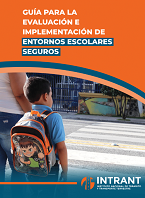
Guía Metodológica para Entornos Escolares Seguros en República Dominicana
Revisores: Francisco Alonso, Jorge Suárez, José Luís Velarte
(2020). LlibreLa guía tiene el objetivo de adaptar el entorno escolar a las necesidades de niños, niñas y adolescentes, para así disminuir el riesgo en sus desplazamientos desde y hacia los centros educativos. De acuerdo a los datos nacionales consolidados por el Observatorio Permanente de Seguridad Vial (OPSEVI), para el año 2019, del total de fatalidades producidas por el tráfico, aproximadamente el 14% fueron niños, niñas y adolescentes menores de 20 años, es decir, fundamentalmente en edad escolar. La Guía de Evaluación e Implementación de Entornos Escolares Seguros, es un documento técnico que contiene la información necesaria y relevante para llevar a cabo un plan efectivo que obtenga resultados...
La guía tiene el objetivo de adaptar el entorno escolar a las necesidades de niños, niñas y adolescentes, para así disminuir el riesgo en sus desplazamientos desde y hacia los centros educativos. De acuerdo a los datos nacionales consolidados por el Observatorio Permanente de Seguridad Vial (OPSEVI), para el año 2019, del total de fatalidades producidas por el tráfico, aproximadamente el 14% fueron niños, niñas y adolescentes menores de 20 años, es decir, fundamentalmente en edad escolar. La Guía de Evaluación e Implementación de Entornos Escolares Seguros, es un documento técnico que contiene la información necesaria y relevante para llevar a cabo un plan efectivo que obtenga resultados a corto plazo desde el momento de levantamiento de información hasta su posterior análisis en áreas circundantes a los recintos escolares, así como los trayectos utilizados por estudiantes, su comportamiento con relación a la movilidad vehicular y peatonal y su seguridad para el traslado de los estudiantes.
Leer más Ocultar ISBN: 978-9945-9238-9-6









